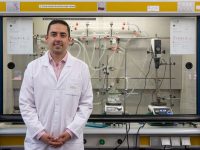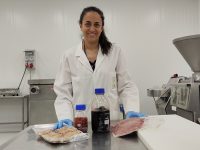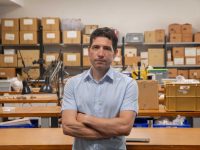Interview with George Whitesides
«Chemistry has always been the ultimate nanotechnology»
Professor of Chemistry at Harvard University

Throughout his career, George Whitesides (Louisville, U.S.A., 1939) has developed powerful nanofabrication techniques such as soft lithography and molecular self-assembly. His research earned him the 2008 Prince of Asturias Award, among many other awards and recognitions. In this interview we asked him about his own particular vision of nanotechnology and other scientific issues of current interest in the U.S.A. Now in his seventies, George Whitesides does not endeavour to be politically correct; nor does he repeat the usual clichés about nanotechnology or attempt to conceal certain arrogance underlying his provocative statements. After a tour of the numerous laboratories he directs in the Department of Chemistry at Harvard University, he sets the ball rolling by asking: «What do you think about what you’ve seen?»
I am astounded by the diversity of projects. How many different scientific disciplines are at work here?
[With a smile of satisfaction] I would say maybe fifteen: biology, engineering, computing, physics, pharmacology, materials science, all kinds of chemists…
And you understand each other?
We try to! There are three reasons to keep up this multidisciplinary spirit. The first is that researchers learn from each other, and that’s very exciting for them. Second, the most significant current issues in science and technology are deeply complex and impossible to deal with from a single perspective. If you’re really intent on doing something important and innovative you have to mix excellent researchers from different disciplines. Nobody can be an expert in cell biology, microfabrication, sensor development and high-resolution microscopy at the same time. And the third reason is simple: always working within the same field is boring. It’s more interesting to change from time to time, have several projects in hand, refresh yourself and try out original research areas.
Then he explains a specific project that would be impossible to carry out were it not for this approach.
Almost everything we do, though a very good example is the use of electric fields to extinguish flames, which you saw before. To do this research you need people who can work with combustion, electrostatics, thermodynamics, dynamic systems, engineers to design it, and also for everyone to put their heads together to solve the problem. We are very excited about it because it’s a very innovative project and may have applications in industry, energy, construction, the military… There are flames all over the place in our society!
«I’m somewhat indifferent to the term nano. It is not very descriptive nor is it well defined. Its meaning greatly depends on the circumstances»
I find it odd that you haven’t mentioned the words nanotechnology, nanotechnologist… Don’t you like the term nano?
If you want me to be honest, I’m somewhat indifferent to it. It is not very descriptive nor is it well defined. The meaning of nano greatly depends on the circumstances. When I started, they said nanotechnology meant working below one micron. After that they said less than 100 nanometres. Nowadays, if you work in microfabrication, you’ll be working in the range of 50 nm, 10 nm if you’re a chemist interested in particles that can penetrate tissues, and you’ll go down to 2 nm if, like physicists, you want to exploit quantum phenomena. It’s a very flexible concept and you can define it almost however you like.
In fact, you’re pretty critical of nanotechnology. It’s often said that micro is more than enough, and that the term nano is abused, just because it is trendy.
[He moves forward, raises his arms, and adopts a more serious expression] Look, nanotechnology was inspired by two specific promises, neither of which is going to work. The first was with the development of Scanning Electron Microscopy (SEM) or Transmission Electron Microscopy (TEM), which enabled us to see atoms and molecules for the first time. We imagined we would be able to manipulate matter at the atomic level, build new nanoscale machines or robots. That idea never made any sense but has been kept going because people choose to ignore the physical constraints involved. We will not have tiny submarines circulating in our bloodstream –heading for the cancer cell– the blood flow in itself is a huge drawback. Lymphocytes are the size they are for a specific reason, and even they find it hard enough to locate cancer cells; tiny robotic submarines will never manage. The second promise arrived with information technology, microprocessors, electronic circuits and the constant need for them to get smaller and smaller. Here, what’s happening is that conventional microelectronics is already producing such small systems that there is no need to implement the tools of nanoscience at all. Commercial microelectronics works at the 40-nanometre scale, and will reduce this further. In my opinion this will continue to improve, ultimately offering a fabulous range of consumer products, which won’t need reducing any more, and will then colonize other markets worldwide. But progress will be by evolution, not by revolution.
So where, then, will nanotechnology succeed?
It’s already successful in the fields of energy and water sanitation. There we find nanoscale structures everywhere. Nanotechnology was born with certain ideas in mind, but has evolved in other directions. All hydrocarbon fuels are being processed by nanoscale structures on an aluminium substrate. Chemists do it and we call it heterogeneous catalysis, but in fact it’s Nanotechnology. And what about solar energy, now that’s promising! I want to know how photosynthesis works at a chemical level, and use materials science to try to exploit the Sun’s energy just as well as plants do.
I once read a quote by you, saying: «Chemistry has always been the ultimate Nano-technology», in an essay where you claim that, in the field of medicine, it is chemistry, and not molecular biology, which represents the true discipline of the future.
Yes. We seemed to be entering the era of the genome, but as time went on it became clearer that on reading the DNA we didn’t find as much information as we thought we would. The base sequence falls short; it tells us nothing of catalysis or of chemical reactions, which to me are the key to understanding life as we know it. Molecular biology has managed to read the genome, but many things are being left out. This amount of detail is not of much interest to biologists, but it is essential that those who care about the reactions and communication taking place between the elements inside a cell, which is chemistry plain and simple.
«The question about the origin of life boils down to chemistry, it has nothing to do with biology»
You grant chemistry a central role in all areas of knowledge; in fact your research group investigates such diverse areas as complex systems or the origin of life.
For me, the question about the origin of life boils down to chemistry, it has nothing to do with biology. Look, one advantage of getting older is that you get to see a lot of different topics. I am a chemist, but I want to investigate interesting problems. I don’t care how they’re classified, I’ll seek out the chemical perspective. Complexity is a good example. For me it is conceptually remarkable, a discipline that can be applied to energy packets, traffic, neurons, stock markets, molecules within the cell… any system comprising elements that interact with each other in a seemingly random way and then, without understanding why or how, something happens. These emergent properties are impressive; they render us speechless, leaving two basic questions to be answered. The first: Is there a science that can satisfactorily describe the internal laws of this complexity? And the second: that which is new was there before and it’s just a matter of more accurate calculations, or is it really unpredictable?
Are you sure that this isn’t the territory of physicists?
I’ll give you a chemical example. Imagine you know everything there is to know about the structure of a water molecule. Would you be able to foresee the transition from liquid to ice? Or does that happen on a different level? I think that it is fundamentally different, because the second law of thermodynamics, for example, comes into play when there is more than one molecule, not just one. Physicists don’t usually like this approach because they believe that if they take a system apart, from top to bottom, they may come to understand all its characteristics. They tend to be more reductionist, but as a chemist I take a different approach. In the laboratory, we build new complex systems rather than deconstruct existing ones. So we study them in a more holistic way.
And even so you support a multidisciplinary approach…
[He smiles] Let me tell you a story. A couple of years ago I took part in a conference in Avignon on the ethics of nanotechnology (I don’t think there is an ethical problem with nanotechnology, but that’s another story) which concluded that the major challenges currently facing society, such as keeping the planet Earth habitable, providing a health system that reaches the whole world or taking advantage of globalization to redistribute the benefits to society fairly… were all chemical problems.
Globalization too? In what sense?
What is globalization? Job distribution worldwide, following the lowest cost principle. But what kind of jobs? Jobs in production, which are based purely on chemistry. You and I live in countries where we do not have «needs» as such, but rather «wishes.» Any American citizen can have access to safe drinking water and minimal healthcare, but that is not the case in Namibia. The Third World is full of people with specific material needs such as medicine, food or drinking water, all of which are produced chemically. There is much work to be done, and we should try to make sure that they manufacture all these products themselves, simply, to set the development cycle in motion: you provide money for people to buy things, things that someone has to produce, thus generating jobs, which will give them money to buy more things.
There is a lot of talk about how science can help the developing world, but do you think there is really a charitable attitude deep down?
You know in the United States… our priorities are profit driven. Society is convinced that health is a business opportunity, not a social obligation. It is very complex, because –putting it bluntly– you’re shifting the responsibility onto the government, which is inefficient and can’t do anything by itself. The only ones who can make substantial changes are private profit-motivated corporations, but they are more interested in cancer or heart disease, which are diseases related to old age.
To improve the population’s health it would be more efficient to clean the city air than give better monoclonal antibodies during the last six months of life, but here there is no clear business model. So you’re asking me whether medical science is seriously researching robust, low-cost applications, which can have widespread use throughout the population, including those without resources. Bluntly, the answer is no.
One of your projects is specifically aimed at reducing the costs of blood tests in poor countries.
Yes, we’ve designed strips of paper that detect various markers. We’ve already started and the technology is quite advanced, but we can’t implement it large scale until someone says: «We’re interested and want a hundred thousand units to distribute in hospitals to see how it works. If it works well, we’ll order more.» Obviously, the problem is that this product is specifically designed to be very cheap and can be used in India or Africa. Or it could even serve to reduce the cost of blood tests in the United States.
And that means it isn’t interesting…
Exactly. But, if you think about it, there‘s a huge paradox here. In today’s society we are used to accessing free information, which acquires added economic value when it’s managed. By contrast, your blood tests are much more expensive than they might be. And that’s because they are seen as a business opportunity. The consequence is that people control their health much less than they should. It’s absurd, because by producing low-cost analytical systems we could control our body much more efficiently. Health information should –and can– be free, and business opportunities could be sought with the management of this information.
Over half the 2010 U.S. budget for Science is devoted to military research. A great deal of research is funded by DARPA, the U.S. Defense Advanced Research Projects Agency. What do you think about military research?
It’s a complicated issue. Let me explain. In this country, universities that act as major research centres, such Caltech, Harvard, MIT or the University of Chicago, play a complex role in society. We are meant not only to teach, but also to investigate, create wealth, jobs, provide services and advise government. In a sense we are required to think for society. Before the Second World War, the basic function of universities was to teach students, but everything changed after Vannevar Bush wrote his famous report The Endless Frontier, in which he stated that research universities should be concerned with three basic issues: employment, health and national security. And if we look at twentieth century history, it is clear that we cannot underestimate this third point. How much should be invested in national security? There’s no clear answer here, war is really expensive. Obviously it is always best avoided, of course. Always. But being realistic in such an important matter as this, we must recognize that it is not always possible. It is clear that the U.S.A. and the USSR could have saved all that fortune spent on nuclear weapons some decades ago but, on the other hand, is the world better or worse off because of nuclear weapons? I don’t know, but I think it’s probably better, because it has managed to prevent certain nations from entering full-scale war, knowing that they cannot be beaten.
Well…
The fact is that since the Second World War we have had no major wars, only small-scale. It is complicated. But we shouldn’t forget that today’s information technology, materials science, nuclear power and aircraft are largely due to military research.
It could have been done more cheaply by focusing on civil applications directly, without going through the military, couldn’t it?
Yes, of course, you’re right. Much more cheaply, but… would we have done it? Who knows.
So, does your DARPA-funded research have military goals?
No. I’ve never worked on military systems or weapons, nor would I. We provide the scientific foundations, but everything we do for DARPA always has civilian applications, and they are the only ones we think about. Believe me, it’s true, we are convinced of using science to make a better world.
«In most advanced societies, research has become a business that moves a lot of money, with limited flexibility and too much bureaucracy»
In this sense, you have stated very clearly that its aim is to make a difference.
Yes, on three levels: people, concepts and technology. Concerning technology, other researchers and I have been deeply involved with progress in the areas of self-assembly, lithography and low-cost microfabrication, which are being employed by many people, thus creating jobs and wealth. As for concepts, we want to take advantage of the power our position gives us to create new trends. There are a lot of people working on developmental projects, but traditionally chemists have not been involved in them. I’m trying to make it known that there is a vast field of opportunity for chemists to become involved in issues such as water, food, diagnostics, vaccines… And I try to encourage more scientists to work on such projects. And thirdly, people, extremely important. An important goal of ours is to create a research group social structure, where students here focus on fulfilling a better role in society. I think we could change the scientific agenda through students. Don’t get me wrong, I’m not manipulating students to follow whatever takes my fancy, I honestly think it is more profitable for them to publish scientific articles in high-impact journals. We have to publish in them too, but it’s not our main interest.
Why have you been so critical of the system of scientific publication?
More than anything, I am critical of the peer review system. It’s very, very, very conservative. What it does is remove all the bad work but, also, much of the best. We publish in order to get funding, which enables us to carry out more daring research, which is what we really want to do. In terms of ethics it is a strange situation, because I’m teaching students to be dishonest about what they are really interested in doing, in order to get money to carry out their ideas. We have to play this game because, in most advanced societies, research has become a business that moves a lot of money, with limited flexibility and too much bureaucracy.
Before finishing, I would like to ask you about the delight with which U.S. scientists have greeted Obama’s election.
There’s been a huge change in the situation, because the first decisions he took reflected a very strong commitment to science. He has surrounded himself with a team of excellent scientific advisors, he has increased funding and vowed never to tamper with scientific results to confirm his political agenda. I accuse George W. Bush of having misrepresented information, particularly with regard to climate change. Obama seems to be going in the right direction, and his words reflect sound principals.
I hope he succeeds. It is not easy, but if he does, it will be an important landmark.
Passejant pel laboratori de Whitesides
A més de poder parlar amb George Whitesides sobre diverses qüestions relatives a la nanotecnologia i a la ciència actual, el químic ens va brindar l’oportunitat de visitar el seu laboratori i conèixer en què treballen els membres del seu equip de recerca.

Infochemicals
George Whitesides is a pioneer in the innovative field of infochemicals, which aims to encode information using chemical reactions instead of electronic zeros and ones. The microfluidic chip created by Roger York and Audrey Ellerbee uses air bubbles to process information. So far, they do not have any application in mind, but they don’t care – it will come.

Levitation
Filip Ilievski showed me some balls of different densities in a paramagnetic fluid, which levitated to different heights when subjected to a magnetic field. It wasn’t particularly dramatic but the most novel thing about it was the simplicity of the technique, patented by Whitesides. It does not require any fluid at supercritical temperatures or any extreme conditions, and can be applied with sensors that exploit the differences in density to detect, for example, whether oil has been adulterated.

Chips for Caenorhabditis elegans
I didn’t understand what scientific question Lizzy Hulme wanted to answer with her chip for the worm C. elegans, made using the soft lithography technique developed by Whitesides. When I asked her she replied: «We don’t do science with tools, we make tools to do science.» The purpose of this device is no more than to permit having a large number of C. elegans in a confined space and thus enable certain types of experiments to be done that could not be done before. Nothing more, nothing less.

Putting out fire with electricity
During combustion, in addition to carbon dioxide and water vapour, large numbers of positively and negatively charged particles are also produced. When Kyle Bishop applied an electric field around a flame, these particles moved, generating an effect similar to wind. The flame moved as if someone were blowing it, and on increasing charge intensity, the flame was put out at once.

3D cell cultures
The chemist Anna Laromaine showed me her post-doc research in Whitesides’ lab. Every cell in your body has a blood vessel nearby providing oxygen and nutrients, but when a tumour grows, layers of cells accumulate so that the central ones are cut off and receive less oxygen. To see what happens in these cases, scientists use cell cultures but a limitation of these cultures is that they are «flat» and it is difficult to reproduce a three-dimensional structure. Anna Laromaine has combined gels with paper to design a very simple structure that allows researchers to position cells three-dimensionally and, for example, reproduce a tumour-like structure in vitro.

Diagnosis for everyone
These little coloured paper strips that Anna Laromaine shows us are tests to analyze our blood and urine samples easily and cheaply. The idea of a lab-on-a-chip is not new, but George Whitesides is obsessed with lowering the price of technology so it can reach developing countries on a large scale. This chromatographic paper chip, designed with microfluidic techniques, can detect levels of glucose, proteins and other data relating to health at a very affordable price.






